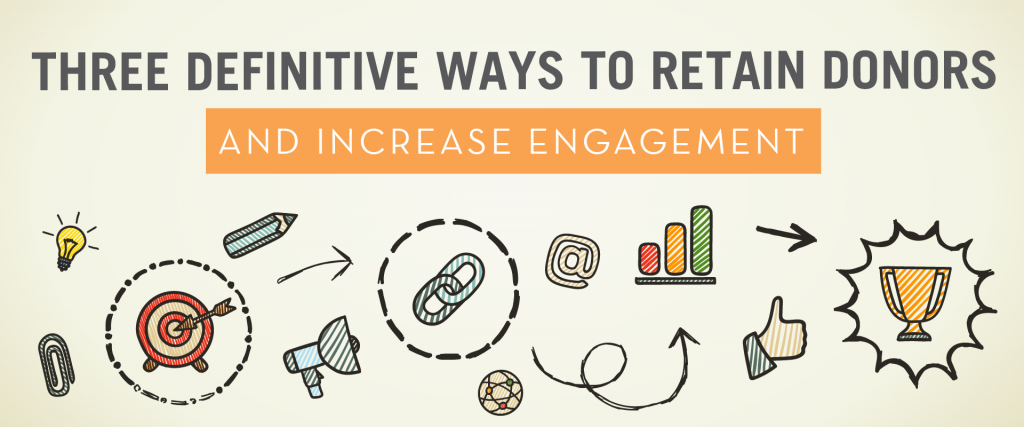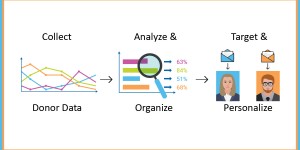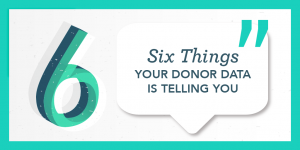We’re in the midst of the end of year appeal season. If you’re in fundraising, that means right now your organization is going big. Whether solicitation mailings are well planned and stick to a schedule or are in the fly-by-night category, it’s what will happen after the ask is made and the checks are cashed that determines whether your existing and new donors are engaged or disenchanted.
Here’s some food for thought:
%
of your donors will be retained
dollars were lost for every $100 gained
%
increase in retention doubles LTV of donor base
From the 2016 Fundraising Effectiveness Project Survey Report conducted by Bloomerang and LTV stat from Adrian Sargeant.
When an organization has successfully inspired an individual to give, that moment is the beginning of a partnership and not a business transaction. In order to retain our donors, we must begin to treat donations as investments and not gifts. When a donor invests in your organization, it’s crucial to demonstrate how their dollars are impacting the performance or service of the organization. When a donor feels like an investor, their desire to stick it out and see the organization succeed increases. In a 2013 report released by Blackbaud entitled The Next Generation of American Giving, they state that donors cite the unending ask and lack of any follow up communications as major reasons why they stop giving.
So what can be done to fight the good fight? Here are 4 strategies:
1. Give your mail a makeover
Your Gen X-er’s and Baby Boomers probably prefer mail, so send them a bold, impeccably designed thank you card in a containing envelope that stands out because of color or shape. It doesn’t look like the letter they’re expecting, so they’re more likely to open it. Now, since you’re not mailing to your millenial donors, put together a really funky email that is chock full of videos and pictures.
Use these formats to stand out as you communicate throughout the year and remember that not every message should contain an ask. You’re building a relationship, so keep things personalized, conversational in tone and relevant to your organization’s story. The donation has already been received, so your goal here is to remain top of mind. Spread the responsibility of this task across your staff, board, and volunteers. Another plus? Because you’re printing and mailing to a significantly smaller group, your cost will stay down.
2. Give them a ring in 6 months
The relationship building process is much like courting your donors, but this step doesn’t involve a diamond. Around the six month mark, it’s more than appropriate to give your current donors a phone call. Thank them again for their support and let them know what’s been happening since they made their donation. Have some stories or statistics ready to share, and be prepared to answer questions. Again, your donor is your partner and your job is to make them feel invested in your organization. Listen to suggestions and find ways to keep them involved. If you have a special event coming up, maybe there’s a way to involve them in the planning process or as a volunteer. You’re not handing over the reigns, you’re just creating pathways for engagement. The more ingrained you are in the hearts of your donors, the more likely they’ll want to continue supporting you.
3. Read the story your data is telling you
As fundraisers, we all know the importance of data. Go beyond your donor data and start looking at engagement analytics. This information is telling you a story that can sometimes save you time and money. Some really good data will come from the emails you’re sending and from your website. Look for these:
- Click through and open rates will tell you what stories work and which ones don’t.
- Conversion rates on your donation page will let you know if that page needs optimizing. If the page views are high, but the percentage of people actually donating is low, something isn’t right.
- Losing followers or subscribers? Maybe you’re sending too much.
Organizations invest in their communications (like donors invest in them), and everyone wants a return on their investment. Pay attention to the numbers and use the information to optimize future moves.
4. Hit ’em when they least expect it
Anyone who makes charitable contributions is conditioned to expect a heavy push of solicitation communications at the end of the year. When you think about it the competition is fierce, and nowadays people are bombarded by messages from everywhere during the holiday season. Getting into the habit of communicating with your donors regularly will help cut through some of the end of year clutter.
Summer is generally a hard time to get in touch, but a well thought out multi-touch campaign can do the trick when there’s less noise for you to quiet. By this point in the year, it’s also reasonable for you to reach out with an ask. By the summer you know whether or not you did as well as you needed or wanted to. Be specific with your ask and keep your donor at the center of the story, this way clear that only they can make the difference.
The Wrap Up
By extending the life cycle of donor communications to include more engaging messages that don’t always include an ask but instead focus on strategic storytelling, fundraisers can begin to win the battle of donor attrition. Like any communication endeavor, it takes time to see results. Starting small with consistent, manageable efforts is half the battle.
You Might Also Enjoy:
+ Before You Make the Ask: Build Relationships By Being Personal
+ The Great Fundraising Balancing Act
+ 4 Keys to Meaningful Donor Stewardship
Bonus Offer!
Our latest whitepaper, Three Definitive Ways to Retain Donors and Increase Engagement, is chock full of valuable insight that will (hopefully) help get you over the hurdle. Improved retention can bring nonprofits an increase of total donors, better relationships, more planned gifts, volunteer or board service, and larger gifts over time. There are also marketing implications to having a base of loyal donors. When your constituents are excited and feel valued, they’re more motivated to spread the word.
Our paper will provide you with an overview of:
- Advanced personalization techniques
- Cross-channel integration
- Data optimization
- Insight into drivers of donor loyalty
Interested? Get access to the paper here.

Like what you see? Stay in touch!











